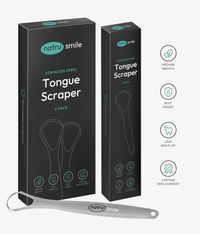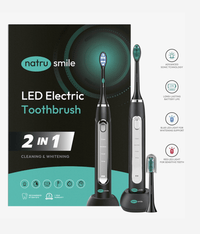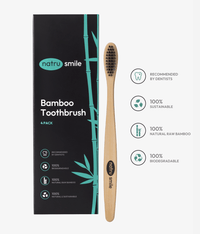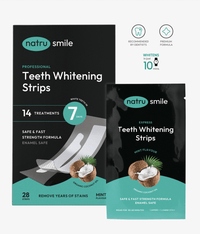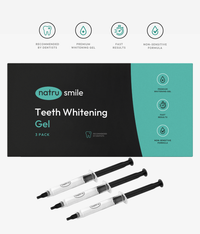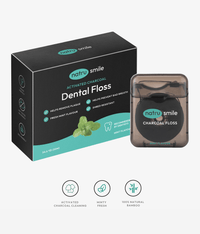
All products are certified by dental expert Dr. Greg Grillo
Among at-home teeth whitening solutions, baking soda is one of the most popular. Its use in whitening has been around just as long as toothpaste has.
So, given its long-term popularity, you might assume it's the most effective whitening solution.
However, numerous studies on the substance have taken place over the years. These studies provide a magnifying glass of the science behind how baking soda works.
So, does baking soda work as a teeth-whitening tool? This article will answer that question and provide more details on how to use baking soda in your oral care routine.
Is Baking Soda Good For Whitening Teeth?
Based on a collective view of the available data, baking soda effectively whitens teeth. Its abrasiveness is safe enough for use on teeth but is still effective at removing stains, making it similar to other natural teeth whitening solutions.
According to a collection of studies from JADA (The Journal of the American Dental Association), it was found that baking soda products work well for stain-reducing and whitening properties. The studies also found this additional data:
- Baking soda is effective in addition to toothpaste for safe daily use.
- Baking soda products work well against oral pathogens, reducing plaque and gingivitis.
- It also neutralizes plaque acids, which helps supports a tooth's natural ability to repair itself.
So, plenty of data affirms the claim that baking soda is a safe and effective means of teeth whitening. However, it is most effective when used alongside fluoride-based products.
A 2017 American Dental Association (ADA) study found that baking soda combined with toothpaste could also be effective. This is why you often see baking soda toothpaste for sale, as the combination can improve your results.
Baking soda combined with toothpaste products has been around since the 1980s.
This tells us that baking soda can be effective but is not a replacement for toothpaste. It also does not replace other oral hygiene practices, such as mouthwash or flossing.
Steps To Whiten Teeth With Baking Soda
You can follow these steps if you want to start using baking soda to improve your smile.
1. Mix Baking Soda And Water
You'll want to mix equal parts baking soda and water in a glass or bowl. The water helps turn the baking soda into a usable paste.
If your paste is still liquid, add a bit more baking soda. The consistency won't match toothpaste but should easily stick to the surface of your brush.
Alternatively, if the paste is gritty, add more water to make it more paste-like.
Because baking soda and water aren't acidic, it's a great way to whiten sensitive teeth. Alternative teeth whitening supports, like watermelon (which relies on malic acid), might be uncomfortable in your mouth. So if you have sensitive teeth, baking soda might be a good solution.
However, some people like to add a bit of lemon juice to the mixture. While this can help with short-term whitening, the acidic content of lemon juice isn't great for teeth. Much like drinking orange juice, the effects of lemon juice might do more harm than good.
You'll also want to take a secondary cup of water to the sink. This will help you with step three of this process.
2. Brush Your Teeth With The Baking Soda Paste For 1 To 2 Minutes
Much like you would with regular toothpaste, you'll want to brush your teeth with the baking soda paste for up to two minutes. Continue brushing until you cover all of your teeth, ensuring each of them can feel the benefits of white teeth.
Set a timer on your phone (or an egg timer if you don't have a smartphone) to reap the most benefit. This way, you don't end up over or under-brushing your teeth.
If you don't want to pull out your phone for a timer, you might consider humming a tune in your head. Look up "two-minute songs" on Google to find some options.
The Beatles make some incredibly catchy songs that are just under two minutes. "Sgt Pepper's Lonely Heart's Club Band" is one of the more famous ones that sit for around two minutes.
3. Rinse Out Your Mouth When You're Finished Brushing
After you are confident that the baking soda is where it needs to be, your next step is to rinse out your mouth. If you followed our advice in step one, you already have that cup.
You can use the same cup as before. However, you'll need to rinse it with water to remove any lingering residue. You don't want any residue from the baking soda to remain in your rinsing water. This is why we suggest a new cup, as there's no risk of the fresh water holding the extra baking soda.
While you might be tempted to use mouthwash at this step, don't. There's no telling how the mouthwash will feel in your mouth when combined with the baking soda. While it isn't likely harmful, it might leave an unpleasant chalky feeling in your mouth.
4. Repeat Every Other Day For Up To 2 Weeks
You'll want to take a minimum of two weeks every other day before seeing the whitening results. By staying consistent, you are more likely to see those results clean your teeth over time.
Baking soda and water combinations aren't likely to work immediately unless you have easy-to-remove stains. There are no whitening solutions that offer immediate results.
However, if you are looking for faster results, you might consider in-office teeth whitening. This cosmetic procedure can lead to much quicker results, although it costs much more than baking soda.
This is why many people prefer baking soda over whitening products. You can get an 8-ounce box of pure baking soda from Arm & Hammer for about 25 cents per ounce. You might even get better rates if you buy this in larger quantities.
Arm & Hammer baking soda is specifically sided in another study involving 270 subjects where baking soda was found to be an effective way to remove plaque. While brand names don't typically matter, using pure and proven sources keeps you safe and increases your odds of whitening.
Baking Soda Alternatives
At-home teeth whitening is a bit of a process of trial and error at first. You might consider alternative solutions if you don't get the best results after two weeks of using baking soda.
Below, you'll find some more popular alternatives to using baking soda to whiten your teeth.
Use Hydrogen Peroxide
Hydrogen peroxide is one of the most popular at-home teeth whitening variants. Much like baking soda, its popularity comes from its long-term use for teeth whitening. Hydrogen peroxide has been available for many years.
It also has numerous studies supporting its effectiveness.
A 2004 study showed that a 25% hydrogen peroxide solution resulted in whiter teeth. You can do the same with a 5% solution, but it would take far more applications to become effective.
But Is It Safe?
The effects of hydrogen peroxide on tooth enamel, it can damage teeth at high concentrations. However, it is unlikely to cause the same damage at low concentrations, making it safe when diluted.
If you want to use hydrogen peroxide to clean your teeth, you can follow the same steps we provided above for baking soda. Instead of baking soda, you should put it in hydrogen peroxide. You'll still want to brush your teeth with the substance for two minutes, rinse it off, and only do it every other day.
Mixing it with water allows you to dilute the solution to make it more manageable. For those who experience sensitivity after whitening, water can help dampen the effects, making it safer.
You can also safely use hydrogen peroxide and baking soda to leverage the benefits of both materials. Fill half the cup with water and the remaining parts with 1/4 each of hydrogen peroxide and baking soda. You'll still want equal water compared to the other compounds.
Brushing And Flossing
Despite all of the DIY teeth whitening methods you can use, it all starts with keeping a clean mouth. Regular brushing and flossing will maintain your oral health, which will assist it in becoming whiter.
When brushing, be sure to pick up fluoride-based toothpaste. Fluoride is a proven substance to help remove cavities, which can lead to tooth decay if left unchecked.
You can also pick up toothpaste that includes baking soda as an ingredient. In many of the studies we cite throughout this article, baking soda toothpaste is shown to be more effective than alternative kinds of toothpaste.
When flossing, pick whatever floss is recommended by dentists. Flossing is integral to your oral care routine because it removes hard-to-reach debris in your mouth. Despite what your toothbrush can do, flossing helps fill in the gaps of what it can't.
Teeth Whitening Products
Outside of natural whitening, several teeth-whitening products can be very effective. Some are specific for whitening, while others are built into existing dental products.
We've already mentioned baking soda toothpaste as one option. Seeking out teeth-whitening toothpaste is a great way to clean and whiten your teeth in one motion. This saves you a bit of time during your oral care routine.
You can also find teeth-whitening mouthwash containing compounds like hydrogen peroxide to help remove stains from your teeth. With regular use of these products, you can see long-term results from their use.
Finally, there are some products made specifically for teeth whitening. At-home teeth whitening kits include trays or strips that you hold in your mouth. Holding these trays allows the compound inside to work towards whitening your teeth.
Meanwhile, you can work on other tasks, keeping yourself busy.
The problem with these at-home kits is that you often can't take them to the office. You can easily hide teeth whitening strips, but it might be more challenging to hide trays.
Professional Teeth Whitening
When at-home teeth whitening solutions aren't enough, you can seek professional teeth whitening. This in-office teeth whitening can yield faster results, leading to whiter teeth in a shorter period.
By setting an appointment with a cosmetic dentist, you can segment some time to get this done. Procedures will often occur every two weeks until you reach your desired results.
Of course, the drawback of this is the cost. When people compare in-chair vs. at-home whitening, they often cite the cost as a significant drawback. At-home alternatives, like baking soda, are preferred to save money.
Wrapping Up
So, from this article and numerous studies, we can confidently say that baking soda can help whiten teeth. However, this whitening isn't a replacement for a good oral care routine.
In addition to a good oral care routine, baking soda can remove stains from your teeth. This is similar to other at-home teeth whiteners, professional dental visits, and the use of hydrogen peroxide.
When using baking soda, follow the steps mentioned above to get it done right. Mix your baking soda with an equal measure of water, coat your toothbrush, use it for two minutes, and rinse out your mouth. Doing this every other day can help your teeth.
Below are some related questions when using baking soda for teeth whitening.
Does Baking Soda Get Rid Of Yellow Teeth?
Because baking soda is a mild abrasive, it can help you get rid of yellow teeth.
Baking soda and water can easily take care of surface stains. In combination with regular oral care, you are likely to see an improvement within two weeks.
What Happens If You Put Baking Soda On Your Teeth Every Day?
Putting baking soda on your teeth every day can potentially lead to damaged tooth enamel. Baking soda isn't meant to replace your regular oral care routine, so you should brush every other day at most. You should also avoid brushing too hard, which can lead to damaged enamel.
Does Baking Soda Whiten Teeth Instantly?
Baking soda will not whiten your teeth instantly. Instead, it works best for removing surface stains and some more set-in stains after a bit. Typically, you'll see the results of using baking soda for teeth whitening in about two weeks. You might have to take extra steps depending on the severity of your stains.
Can Baking Soda Whiten Teeth In One Day?
No, baking soda will not likely whiten your teeth within one day. However, if most of your stains are very mild, you might immediately see some pretty impressive results. Thankfully, you won't have to wait too long, as you might see results within a few weeks.
How Long Does It Take for Baking Soda To Whiten Your Teeth?
There's no set time for how long it takes baking soda to whiten your teeth.
However, most people using the baking soda and water combo see some changes within two weeks. Sometimes, it can take a few more weeks to see results. This might vary depending on the severity of your tooth discoloration.
How Do I Whiten My Teeth With Baking Soda In 2 Minutes?
Mix your baking soda with equal water in a glass or a small bowl. Then, you can take the paste that forms and put it on your toothpaste and start brushing your teeth. Typically, you should only brush your teeth with baking soda between one and two minutes. You can also save more time by using baking soda toothpaste.
Should I Brush My Teeth With Baking Soda Before Or After Toothpaste?
You should brush your teeth with baking soda before using toothpaste. You don't want any baking soda residue lingering on your teeth as you sleep. Using toothpaste at the end increases your chances of removing any lingering traces of baking soda.
Can I Mix Baking Soda With My Toothpaste?
You can mix baking soda with your toothpaste to create a DIY toothpaste. To do this, sprinkle a small amount of baking soda on top of your toothpaste when it's already on the toothbrush. You'll still want to rinse off the toothpaste and baking soda at the end, but there is no harm in mixing these two household oral care tools.
How Many Times A Week Should I Whiten My Teeth With Baking Soda?
At most, you can whiten your teeth with baking soda three to four times per week. However, you can also limit your use of baking soda to once per week.
This change can occur as you start to see results from using the baking soda over time. You might not have as much need for it after long-term use.


